Dell XPS 14 OLED review: A vibrant and gorgeous display
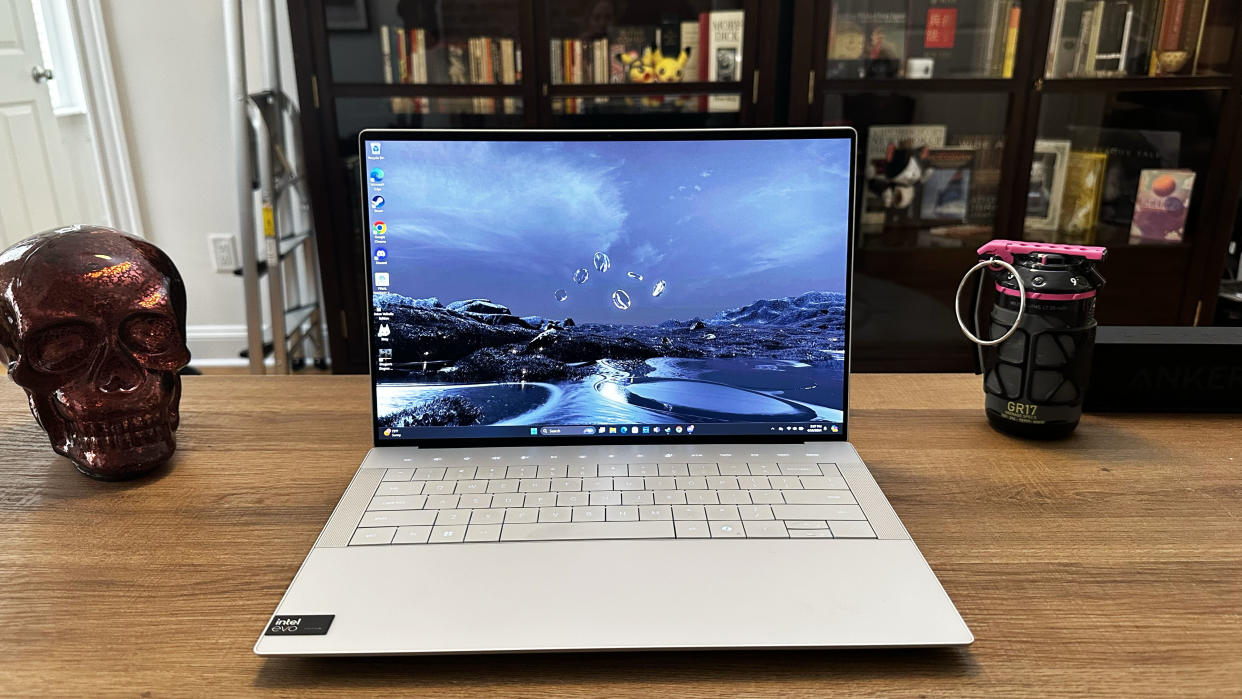
At some point in the last couple of years, we’ve decided that even numbers are the best form factor for laptops. More and more companies are offering 14-inch and 16-inch laptops, often in place of the 13-inch and 15-inch form factors of previous years. Dell’s XPS line is the latest to join that trend, though you can still get the traditional 13, 15, and 17-inch chassis.
We received two XPS 14 models for review: one with the FHD non-touch panel and one with the 3.2K OLED display. The OLED display is vibrant and gorgeous, with fast, reliable performance, a hyper-modern design, and decent battery life. The XPS 14 OLED is held back from perfection by a dim display, a lack of USB-A or HDMI ports, a grainy webcam, and a soft keyboard.
We’ve loved the XPS platform for years, but do the XPS 14's benefits outweigh its drawbacks enough to make it onto our best laptops list? Or perhaps just among our best 14-inch laptops?
Dell XPS 14 (April 2024, OLED): Specs
Dell XPS 14 (April 2024, OLED): Price and configurations
The XPS 14 OLED launched Photoshop as quickly as my usual MacBook Pro when plugged in.
The Dell XPS 14 starts at $1,699, which comes with an Intel Core Ultra 7 155H CPU, Intel’s integrated Arc Graphics, 16GB of DDR5 memory, 512GB of SSD storage, and a 14.5-inch FHD InfinityEdge non-touch display.
Our OLED review unit came with a few optional upgrades, including discrete Nvidia GeForce RTX 4050 graphics, 32GB of memory, 1TB of storage, and the 14.5-inch 3.2K OLED touchscreen display, which retails for $2,699.
You can also configure the XPS 14 with up to 64GB of memory, 4TB of storage, Windows 11 Pro, and the Intel VPro platform.
Dell XPS 14 (April 2024, OLED): Design
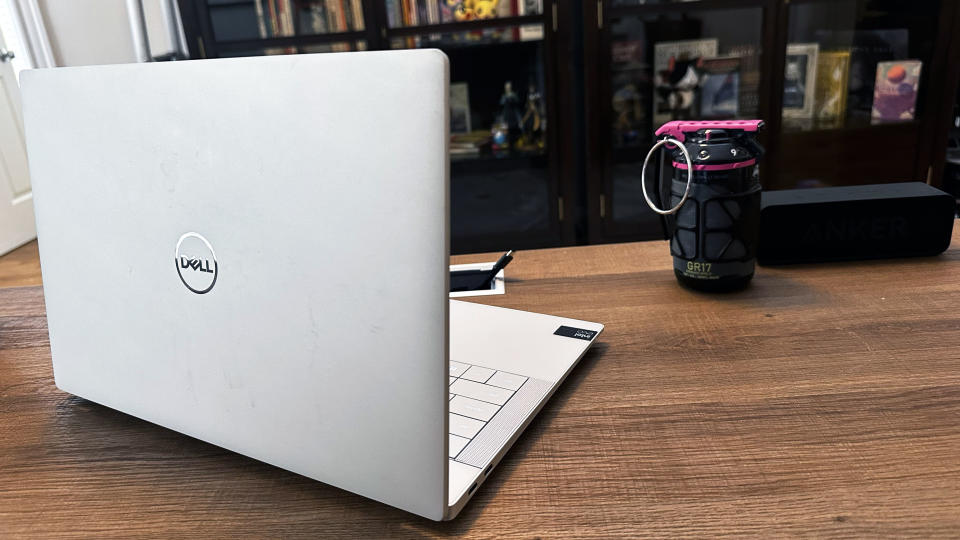
The large keys with minimal space between them, the flat panel handrest, and the touch function row give the Dell XPS 14 a futuristic look.
The updated XPS design has been something of an acquired taste for the last few iterations, with a vanishing edge trackpad and light-up function row. The XPS 14 comes in a dark graphite or the more standard platinum. We were blown away by the graphite design on the FHD (“Full High Definition”) model of the XPS 14. Although the platinum is less exciting to look at, it features the same hyper-modern, minimalist aesthetic.
The large keys with minimal space between them, the flat panel handrest, and the touch function row give the Dell XPS 14 a futuristic look that has absolutely grown on me. I wasn’t a huge fan of the design at first because it feels like Dell chose form over function, but the touch function row bothers me a lot less than similar iterations, like Apple’s infamous Touch Bar.
When it comes to portability, the XPS 14 is a little on the heavier side at 3.8 pounds, though it maintains a slim figure at 12.6 x 8.5 x 0.71 inches. With a 14.5-inch display panel, the XPS 14 is slightly more portable than its larger Windows competition, like the MSI Prestige 16 AI Evo, which measures 14.11 x 10.01 x 0.66 inches but weighs only 3.3 pounds. The Apple MacBook Pro 14 M3 is thinner and lighter than the XPS 14, measuring 12.3 x 8.7 x 0.6 inches and weighing 3.4 pounds.
While its Windows and Mac competitors are trimmer, the XPS 14 is still light and thin and should fit easily in any backpack or laptop bag.
Dell XPS 14 (April 2024, OLED): Ports
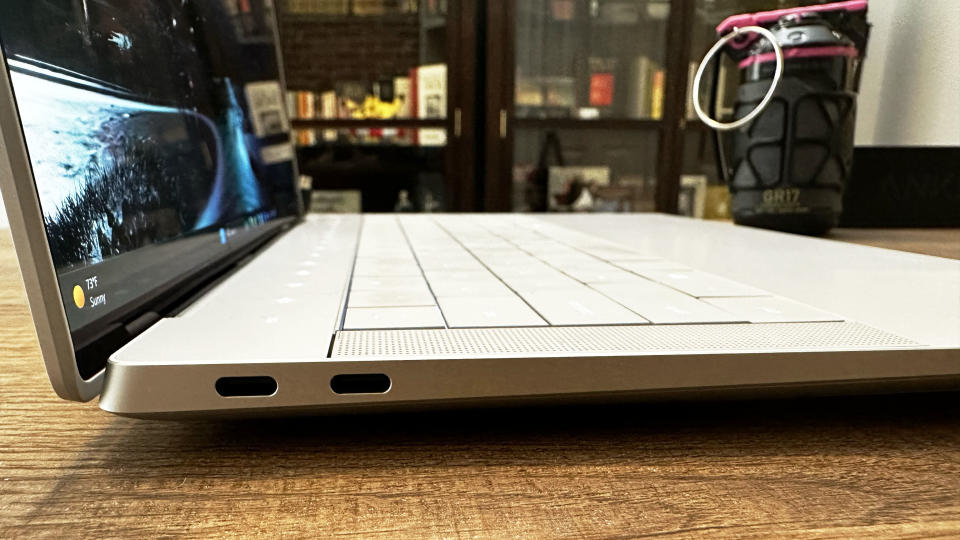
Ports are in short supply these days — even on premium laptops. The thinner the laptop, the less space there is for ports, so you need to do some calculus to determine if a laptop’s port array is enough for your needs. The XPS 14 has three Thunderbolt 4 USB Type-C ports, a 3.5 mm audio jack, and a microSDXC v6.0 card reader.
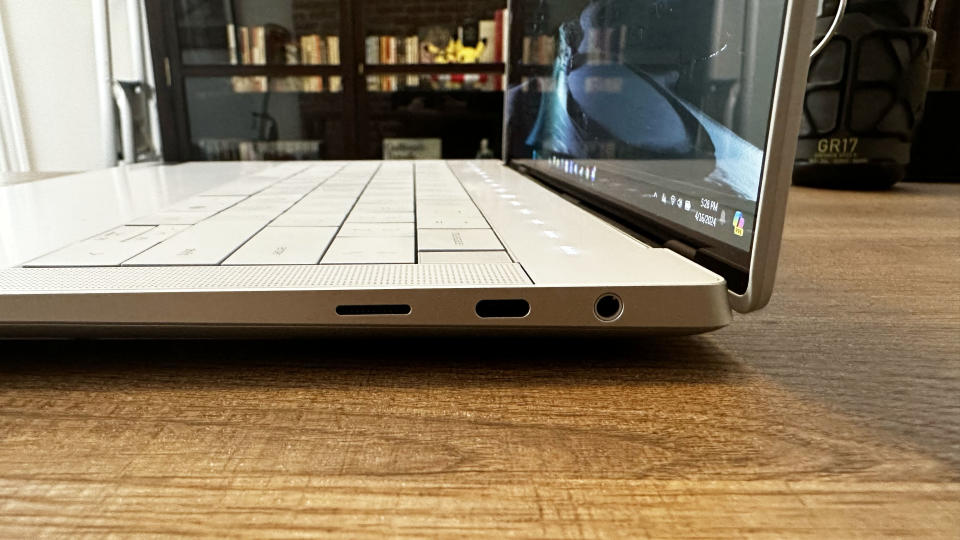
The XPS 14 and XPS 16 ship with Dell’s USB-C to USB-A and HDMI adapter dongle, which provides some additional flexibility. But who likes to carry around a dongle?
I use a MacBook Pro 14 as my main laptop, and being stuck with using a USB-A dongle to use some of my favorite accessories is a constant point of contention. At least the MacBook Pro has an HDMI port ready when I need a monitor.
The XPS 14 includes a third USB-C port, which you can use for a monitor connection. However, if you have an older monitor (or you prefer HDMI or DisplayPort connections), you need to use a dongle, which just adds to the clutter in your desk drawer or laptop bag.
That said, if you want to feature the XPS in a permanent desktop setup, investing in one of the best USB Type-C hubs or best laptop docking stations to kit out your workspace is worth the effort.
Dell XPS 14 (April 2024, OLED): Security
The XPS 14 comes with a 1080p webcam and a fingerprint scanner that can be used for secure Windows Hello sign-in. The FHD webcam is on the small side, designed to fit within the XPS 14’s InfinityEdge display bezels, so it lacks a privacy shutter.
Dell XPS 14 (April 2024, OLED): Display
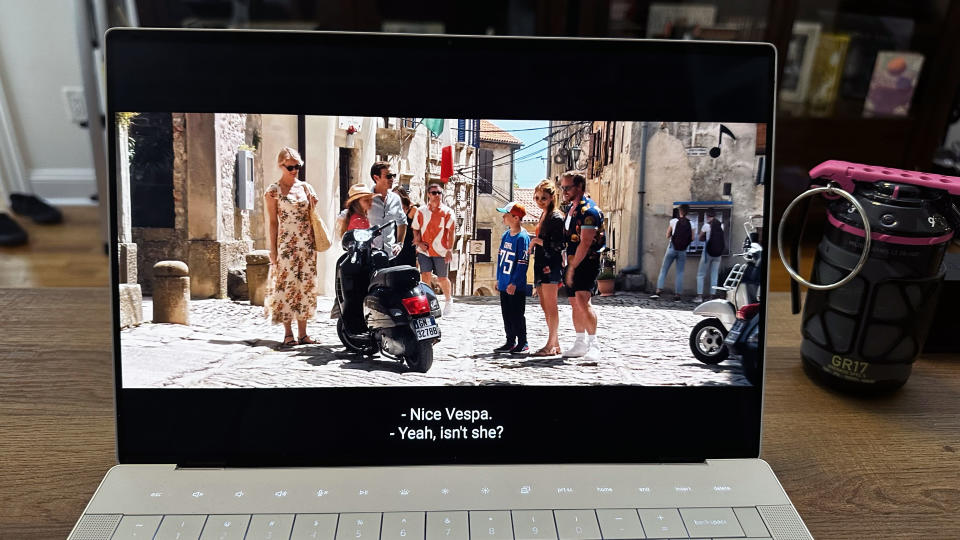
OLED displays are often gorgeous to look at, and the XPS’ 14.5-inch OLED is no exception.
While watching a trailer for Universal Pictures’ Speak No Evil, based on Danish horror film G?sterne, I was impressed by the vivid colors and how the OLED display captured the film’s stunning, wide panoramic views. The display panel seamlessly transitioned into glossy close-ups in the European city, complementing the idea of an American family on vacation. When the trailer’s action moves into the countryside manor of James McAvoy and his strange family, the XPS kept up with both the quick action shots and the terrifying, dark exterior sequences for a properly suspenseful horror movie trailer.
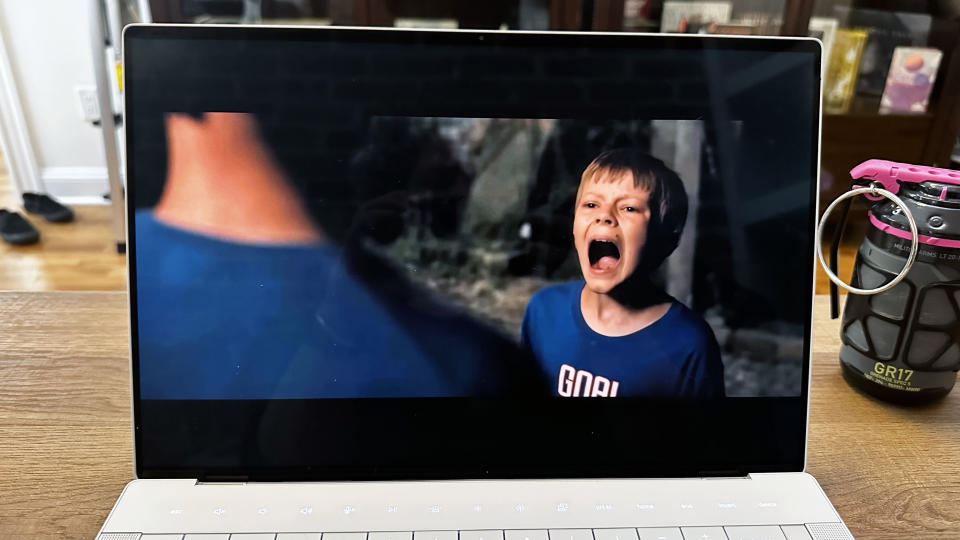
Our lab display tests backed up my experience, revealing that the XPS 14 OLED panel covers 79.9% of the DCI-P3 color gamut with a Delta-E accuracy of 0.2. The XPS 14 non-OLED model did quite a bit worse on our display test, as the laptop covered only 64.5% of the DCI-P3 color gamut with a Delta-E accuracy of 0.2. Meanwhile, the Apple MacBook Pro 14 was more vibrant than the XPS 14, with 81.3% gamut coverage and an accuracy of 0.12, while the MSI Prestige 16 had the most colorful display with 137.9% gamut coverage and an accuracy of 0.17.
However, I do wish the XPS 14 OLED had a brighter display. With an average maximum brightness of only 377 nits, the XPS 14 OLED pales in comparison to the non-OLED FHD model, which averaged 461 nits of max brightness. The MSI Prestige 16 was also on the dim side (368 nits), while the MacBook Pro 14 was the brightest (558 nits). I didn’t run into any glare problems with the XPS 14, but it is far from ideal if you need to use the laptop outside on a bright day or if you work in a brightly lit environment.
The OLED display’s touch controls were pretty average for a touchscreen laptop, though I cannot recommend them if you have a pet that loves to rub their fuzzy little face along the edges of your laptop screen. I don’t have an accurate count of how often my cat managed to switch tabs on me, but it was enough to include it in the review. If you don’t have to worry about a feline friend wreaking havoc on your online life, the touchscreen is reactive and doesn’t hold onto too many fingerprint smudges.
Dell XPS 14 (April 2024, OLED): Keyboard and touchpad

It’s not the worst keyboard I’ve ever used, but it doesn’t feel great to the fingers, and I want it to be better.
Dell has adjusted the keyboard on the XPS 14 so there is less space between the keys and the actuation depth is deeper than previous iterations of the keyboard. However, it still feels a bit soft and mushy in a way that is far from satisfying. It’s not the worst keyboard I’ve ever used, but it doesn’t feel great to the fingers, and I want it to be better.
A slightly harder actuation would provide more bounce while typing to help maintain speed. I was actually far slower typing on the XPS 14 than average. On the 10FastFingers advanced typing test, I averaged 81 words per minute, which is below my 88-WPM average.
There is a dedicated Windows 11 Copilot key, and the function row keys are touch keys with backlit icons. Pressing “Fn” will switch the preset control keys over to proper function keys. Brightness on the function row is managed by an ambient light sensor, and the platinum-colored keyboard lighting is managed similarly. While you can use the keyboard without the backlight, the function row will remain lit.
The vanishing-edge trackpad feels like it should be an issue, but the trackpad is pretty sizable underneath the flat panel handrest. It is unfortunately impossible to accurately measure, but it is at least 5 inches wide and takes up most of the vertical height of the handrest. You get a respectable amount of touchpad real estate, though the touchpad also has palm rejection software, so you won't accidentally move the cursor with your palm while typing. The haptics on the touchpad are relatively unobtrusive, and feedback strength can be customized if you need to.
Dell XPS 14 (April 2024, OLED): Audio
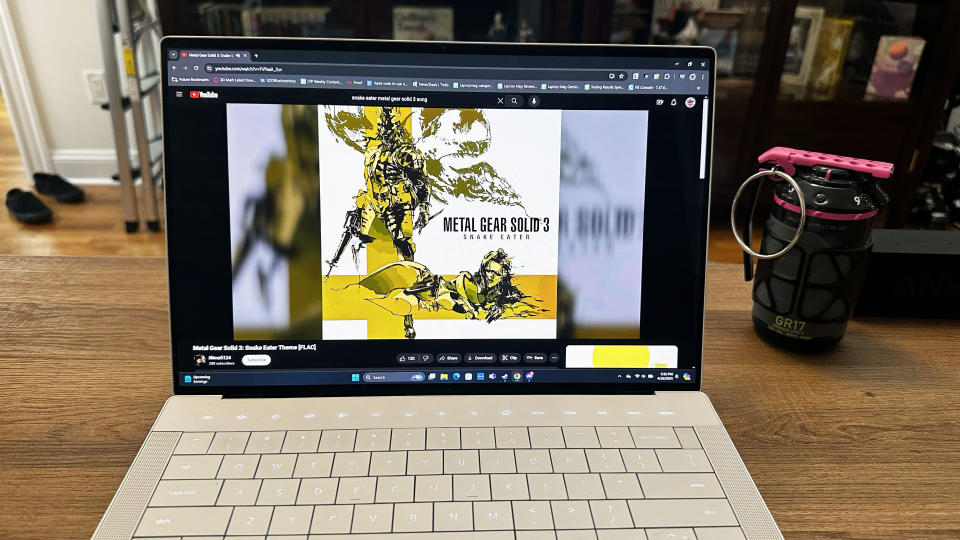
The new 8-watt quad-speaker spatial audio setup in the XPS 14 comes with Dolby Atmos and 3D stereo surround with Waves Maxx. The result is a set of speakers loud enough to startle my cat into full panic mode when I suddenly increased the volume from a comfortable 20% to the maximum setting.
I kicked off my audio testing with Demon Hunter’s “Last One Alive,” which was loud but distorted when the speakers were set to maximum volume. I found a sweet spot for volume and audio quality between 60 to 70% on the volume slider. That provided more than enough volume without tipping the balance into distortion. I could make out the nuance in Demon Hunter’s driving bass and fast-paced guitar riffs.
I switched to Norihiko Hibino’s “Snake Eater” from the Metal Gear Solid 3 soundtrack to see how well the new XPS audio array held up at max volume under less stressful conditions. Crisp highs and mids followed, and I lost far less audio quality with the jazzy Bond-esque Metal Gear tune. (However, my cat was still not a fan of hearing the opening theme at 100%.)
The impressive audio quality is more than enough to handle video calls or Netflix binges. However, if you want immersive surround sound, you’re better served with one of the best computer speakers.
Dell XPS 14 (April 2024, OLED): Performance
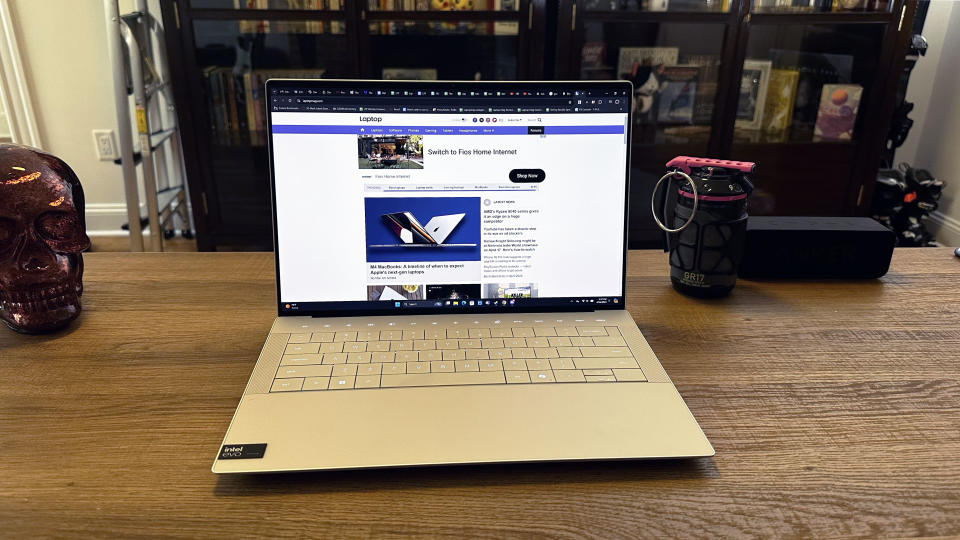
With an Intel Core Ultra 7 155H processor, there wasn’t a number of Chrome tabs I could throw at the XPS 14 that it couldn’t handle the load. The laptop easily kept up with my daily workflow of 10+ Chrome tabs, casual Photoshop use, and near-constant Slack notifications. I did notice a slowdown when launching Photoshop on battery power, but the XPS 14 OLED launched the Adobe software as quickly as my usual MacBook Pro when plugged in.
Our lab benchmarks certainly prove the XPS 14 has the kind of snappy, powerful performance you need to handle any task. On the Geekbench 6.2 CPU benchmark, the XPS 14 OLED returned a single-core average of 2,326 and a multicore average of 12,701. The MacBook Pro 14 M3 had the best single-core performance (3,163) of the bunch and the worst multicore performance (11,968), while the XPS 14 non-OLED model benchmarked similarly to the XPS 14 OLED on both single-core (2,372) and multicore (12,711) metrics. The MSI Prestige 16 AI Evo shares an Intel Core Ultra 7 155H processor with the XPS models but beat them both on single-core performance (2,434) and led the pack on multicore performance (13,310).
The XPS 14 OLED completed our Handbrake 1.6 video encoding benchmark in 5 minutes and 58 seconds, which takes the 4K version of Tears of Steel and encodes the video at 1080p 30FPS. The XPS 14 non-OLED model had a nearly identical performance, taking 5:57 minutes on average to encode the video. The MacBook Pro 14 (5:38) and MSI Prestige 16 (5:17) were faster than the XPS laptops, but not by a huge margin.
On our proprietary File Transfer Test storage benchmark — which tasks the laptop to copy over a 25GB multimedia file — the XPS 14 OLED took 14.56 seconds with a transfer rate of 1844 megabytes per second. The XPS 14 non-OLED model was a bit slower, at 17.86 seconds and a transfer rate of 1503 MBps, as was the MSI Prestige 16, which took 19.2 seconds and had a transfer rate of 1400 Mbps.
Dell XPS 14 (April 2024, OLED): Graphics and gaming
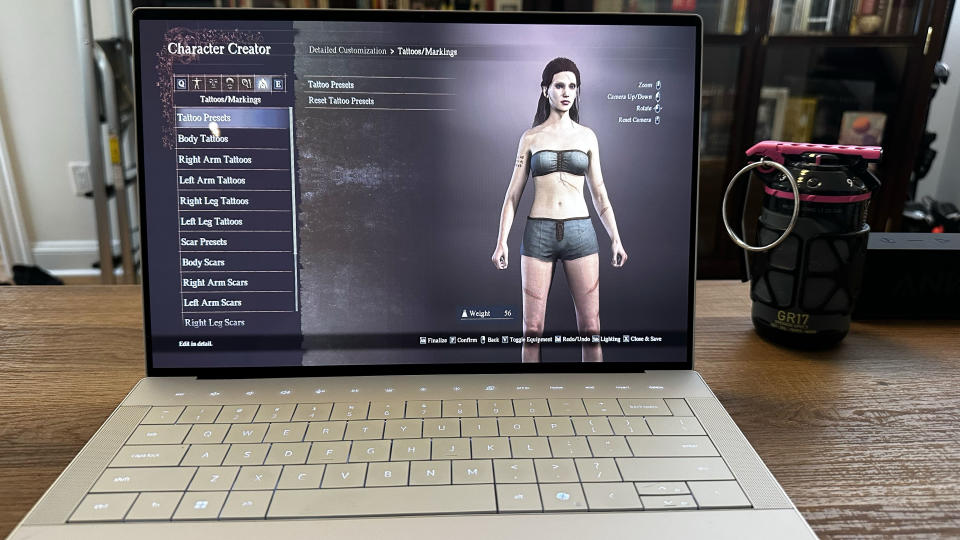
With a discrete Nvidia GeForce RTX 4050 GPU with 6GB of VRAM, you can do some quality gaming on the XPS 14. If you stick to a 1080p resolution, you can get impressive graphic performance on even new demanding games like Dragon’s Dogma 2. Even if I got stuck in the game’s character creator for literal hours, the XPS 14 had no problem keeping up with my constant design tweaks and camera rotations. Out in the open world, I did tend to stick to lower graphic settings, but Dragon's Dogma 2 still looks pretty fantastic at 1080p, so I can’t complain.
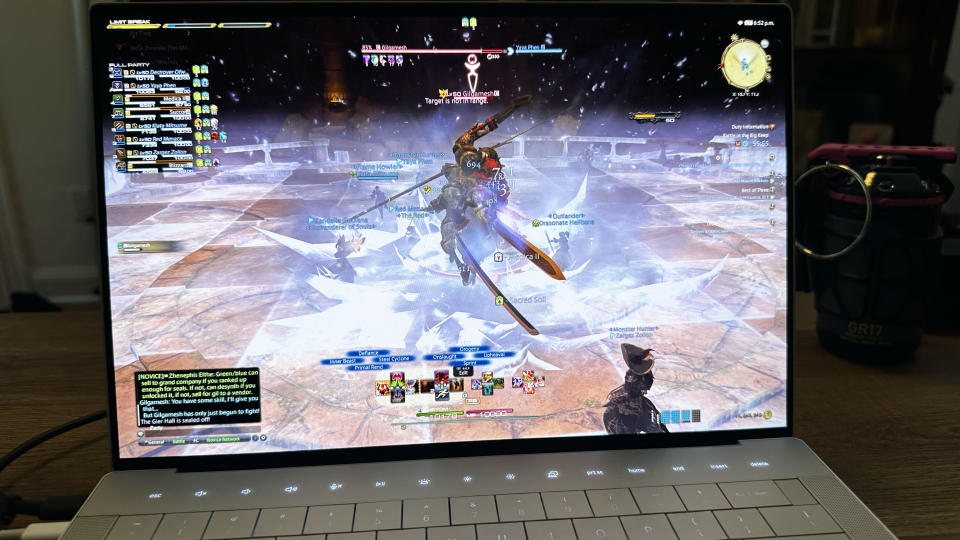
I switched to Final Fantasy XIV for my weekly MMO obligations. The XPS 14 had no real trouble keeping up with even the most chaotic 24-person raids, maintaining a consistent 50 to 60 fps at “Laptop High” settings and the max 3.2K resolution.
On the 3DMark Fire Strike DirectX 11 gaming benchmark, the XPS 14 OLED reached an average score of 12,202, which is a bit lower than the XPS 14 non-OLED model (12,932). When you hit such high scores in 3DMark, even a gap of 700 points is not exactly worrying. As it uses an integrated Intel Arc GPU, the MSI Prestige 16 AI Evo (8,192) benchmarked much lower than the XPS models on the 3DMark test.
We also ran Sid Meier’s Civilization VI: Gathering Storm benchmark at 1080p on medium settings on all four laptops. The XPS 14 OLED averaged 87 FPS, which was just behind the non-OLED model of XPS 14 (88 FPS), and was well above the MacBook Pro 14 M3 (51) and MSI Prestige 16 (66 FPS).
Dell XPS 14 (April 2024, OLED): Battery life
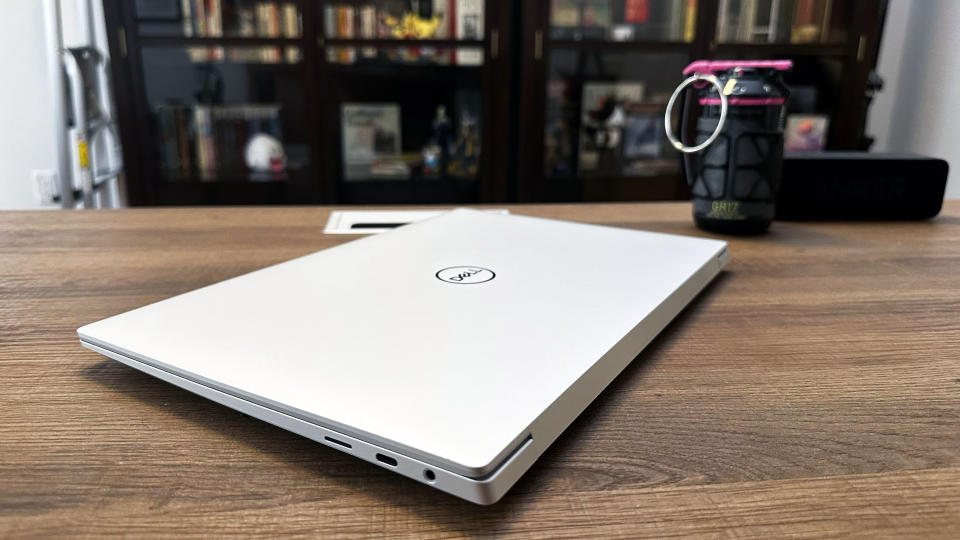
Laptops with discrete GPUs tend to suffer a major hit to battery life, and the XPS 14 is no exception. However, unlike some of its previous iterations, it did last long enough for an average work day even with something like 20 tabs open and some occasional photo editing.
On our Laptop Mag battery test, which sets the display at 150 nits of brightness and continuously surfs through a set of web pages, the XPS 14 OLED lasted 9 hours and 35 minutes. The non-OLED XPS 14 lasted a bit longer at 10:09, while the MSI Prestige 16 AI Evo leveraged its larger battery capacity and integrated GPU for a 13:04 battery average. The Apple MacBook Pro 14 M3 was the leader in this category, with a nearly unbeatable 17:16 battery life.
Given that our benchmark is a web surfing test, 9:35 is not the ideal battery life. So, depending on your daily workflow, you’ll likely get a bit less battery life. But it should allow you to remain untethered from an outlet for a decent amount of time.
Dell XPS 14 (April 2024, OLED): Webcam

The XPS 14 has a 1080p webcam that fits just within the InfinityEdge display bezel, so it won’t leave you with a camera notch or any breaks in the laptop’s design aesthetic. But that’s really where the benefits end. The XPS 14 webcam quality is grainy and tends to put a pink cast over the image, particularly with red in the background.

The bleed from the brick wall behind my desk was noticeable on the default settings and worsened with background blur effects enabled. My colleague was also unimpressed with the camera’s capabilities in reviewing the XPS 14’s webcam.
If you need a professional-quality webcam for presentations and video calls, I recommend using one of our best webcams instead.
Dell XPS 14 (April 2024, OLED): Heat
On our consumer laptop heat test, which streams a 4K video for at least 15 minutes, the XPS 14 OLED hit a max of 96.7 degrees Fahrenheit on the underside of the chassis, which is just above the Laptop Mag comfort threshold of 95 degrees. The touchpad kept a relatively cool 86.7 degrees, and the keyboard was a bit hotter at 89.4 degrees.
You can use the laptop’s keyboard to game, but you’ll want to make sure you rest it on a table or laptop cooler rather than put it directly on your lap. The underside of the XPS 14’s chassis was 94.6 degrees in the center and nearly 97 degrees at its hottest point, which will get uncomfortable fast.
Dell has multiple power and thermal profiles in the MyDell app to make the XPS 14 more comfortable. Still, there’s a performance drop if you opt for the “Cool” or “Quiet” profiles, and the “Ultra Performance” profile may get even hotter than our benchmark, depending on how the laptop is being used.
Dell XPS 14 (April 2024, OLED): Software and warranty
Dell’s support software is pre-installed in the My Dell and Dell Support Assist applications. The XPS comes pre-loaded with either Windows 11 Home or Windows 11 Pro, which means you can access several Microsoft products like Microsoft Copilot and Xbox. Other third-party applications like Intel Command Center, Intel Graphics Optimizer, and Killer Intelligence Center are also preloaded on the XPS.
The XPS 14 has a one-year limited warranty. If you want to see how Dell customer service did in our annual ranking, check out our Tech Support Showdown list.
Bottom line

The XPS 14 OLED has a modern sci-fi design, vibrant display, admirable battery life, and powerful performance for productivity and gaming tasks. It’s also great at photo and video editing, too. If you need one laptop to handle all your computing needs, you could do far worse than the XPS 14 OLED.
On the other hand, it does suffer from a subpar webcam, a lack of USB-A ports, a soft keyboard, and a dim display. Many of these issues can be addressed using an external webcam, laptop docking station, or USB adapter. For some, the soft keyboard may even be a plus.
If you want the perfect laptop that doesn’t require any accessories to excel in your work and home lives, the XPS 14 is perhaps not the laptop for you.
However, if you don’t need those ports or plan to set the XPS 14 up at a permanent desk with a laptop docking station and one of the best keyboards on the market, it’s a fantastic laptop.
